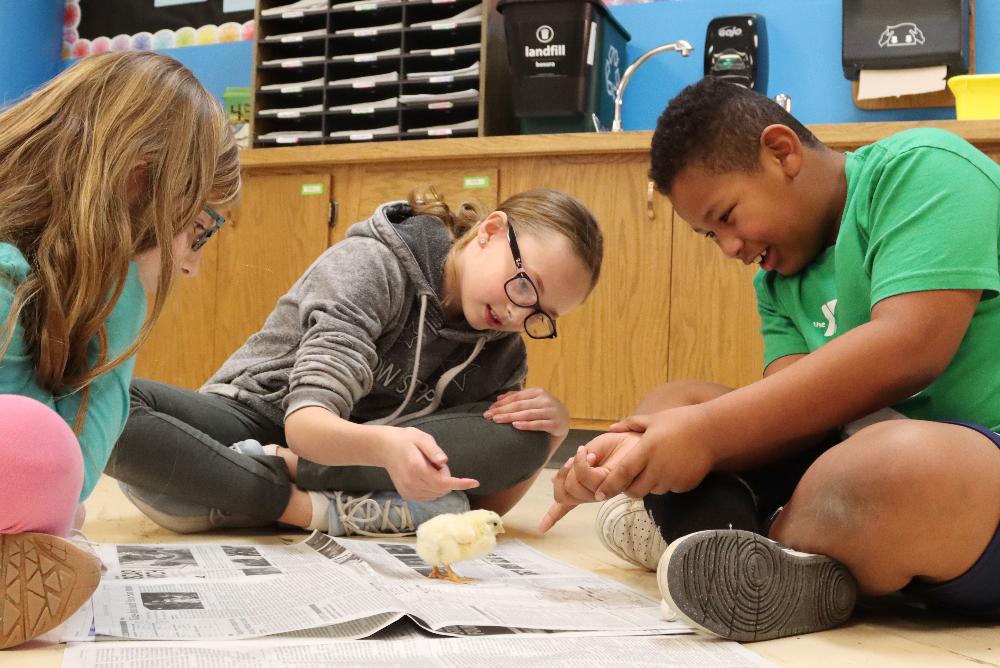Hatching Knowledge: LPS third graders learn embryology with chicks
February 20, 2025
Hatchling became a favorite scientific term for hundreds of Lincoln Public Schools students like Avi, Hudson, Evey and Frazier this winter.
Third graders from across the school district watched chicks emerge out of eggs as part of a popular flamingos unit. Students tracked the entire development process of the chicks in classroom incubators for three weeks. They then celebrated when they heard tiny sounds come from the birthing areas.
Avi, Hudson, Evey and Frazier beamed as they petted the newly-hatched chicks in their Cavett Elementary School classrooms. They said the unit helped them realize how embryos become walking animals in a short span of time.
“When I started learning about how they form and their bodies and everything, I was just like, ‘Wait, that’s what’s happening inside of an egg?’” Hudson said.
“It’s just kind of cool to see something living come out and take life and finally you get to see it,” Evey said.
Megan Videtich smiled with her class as they made those same types of scientific discoveries. Videtich held one of the tiny chicks in her hands and gave each student a closeup view of the yellow-fuzzed animal at their desks. They then told Cavett Principal Kathleen Dering all the facts they had learned over the past few weeks.
Dering said teachers and students look forward to the flamingos unit each year. The lessons are incorporated into the third grade science curriculum and occur during the third quarter throughout LPS. Students learn about the life cycle of a chicken, observe and understand embryonic development and investigate flamingos and other animals that lay eggs. They also discover that all living things follow a predictable cycle of life.
Third grade classrooms receive eggs each winter for the project, and teachers clean and store them inside incubators. They use special thermometers to ensure the eggs are housed at healthy temperatures for the chicks to develop. After the animals are born, students can pet them before University of Nebraska Extension specialists bring them to farmers.
At Cavett, Videtich and fellow third grade teachers Becky Hummel, Jill Markowski and Steph Takahashi gave their students several ways to explore the hatching process. They positioned cameras above the incubators and posted timelines next to the eggs. Frazier said that gave him a better sense of what was happening each hour.
“The signs that our teacher put up to say what days they were at and what was going on in the egg really helped me too, so that I could see what was going on in the egg,” Frazier said.
Evey said she had fun watching the chicks begin to take shape. She joined her classmates at the incubator each day to track the progress of their chick friends.
“You can shine a light into the egg and you can see the vessels,” Evey said.
Embryos begin to move inside eggs after one week, and they begin to form feathers during the second week. Down feathers become visible within 14 days and the claws and beak are fully hardened several days later. The embryo becomes a chick on day 19 and reaches full development after 21 days.
Frazier and Evey said they were surprised to learn that chicks have different appearances inside and outside their eggs.
“They were pretty moist when they were first born,” Frazier said. “They had to start living some more to be able to get their puffy yellow feathers.”
“When people think of chicks, they think of them being fluffy and everything, but they don’t know the whole story of how it comes out of the egg and it’s just kind of wet,” Evey said.
Avi liked comparing the development timeline of a newly-hatched chick with a newly-born human. She was amazed when one of the chicks began to move around as soon as it left its eggshell.
“(My teacher) showed it on the camera, so you could see it hatching in the incubator,” Avi said. “It was very tired, but it learns to stand up really fast. When they’re born and hatched up they rest, and when they’re done, they would just stand right up. But when we get born, we can’t even walk at all. It takes weeks and months.”
Hudson said the science unit completely changed the way he viewed the life cycle of chicks.
“I used to think they were just cute puffballs that just come out of the egg naturally and it’s like, ‘Hey, I’m a chick,’” Hudson said. “Now I’m learning what’s happening. What they look like at the beginning, everything.”
Evey was happy to learn how hatchlings could become friendly creatures in her classroom. She said she would remember the science lessons for a very long time.
“It’s just kind of cool to see how a chick can grow from what it was at the start,” Evey said.
Visit home.lps.org/science to learn more about the many scientific discoveries LPS students are making each day. The website includes curriculum objectives, scope and sequence of classroom lessons and a course guide.
Do you have a story idea? Share it with the LPS Communications Team by filling out this form!
Published: February 20, 2025, Updated: February 27, 2025

Cavett Elementary School students enjoy petting a chick this winter at the conclusion of a science unit. Third graders across LPS learned how a chick is formed inside an egg during a series of lessons. Cavett students said they had fun watching the embryo develop in their classrooms.
